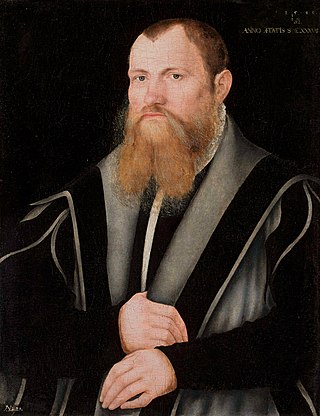
Lucas Cranach the Younger was a German Renaissance painter and portraitist, the son of Lucas Cranach the Elder and brother of Hans Cranach.

Lucas Cranach the Elder was a German Renaissance painter and printmaker in woodcut and engraving. He was court painter to the Electors of Saxony for most of his career, and is known for his portraits, both of German princes and those of the leaders of the Protestant Reformation, whose cause he embraced with enthusiasm. He was a close friend of Martin Luther, and eleven portraits of that reformer by him survive. Cranach also painted religious subjects, first in the Catholic tradition, and later trying to find new ways of conveying Lutheran religious concerns in art. He continued throughout his career to paint nude subjects drawn from mythology and religion.

The German Renaissance, part of the Northern Renaissance, was a cultural and artistic movement that spread among German thinkers in the 15th and 16th centuries, which developed from the Italian Renaissance. Many areas of the arts and sciences were influenced, notably by the spread of Renaissance humanism to the various German states and principalities. There were many advances made in the fields of architecture, the arts, and the sciences. Germany produced two developments that were to dominate the 16th century all over Europe: printing and the Protestant Reformation.

The Protestant Reformation during the 16th century in Europe almost entirely rejected the existing tradition of Catholic art, and very often destroyed as much of it as it could reach. A new artistic tradition developed, producing far smaller quantities of art that followed Protestant agendas and diverged drastically from the southern European tradition and the humanist art produced during the High Renaissance. The Lutheran churches, as they developed, accepted a limited role for larger works of art in churches, and also encouraged prints and book illustrations. Calvinists remained steadfastly opposed to art in churches, and suspicious of small printed images of religious subjects, though generally fully accepting secular images in their homes.
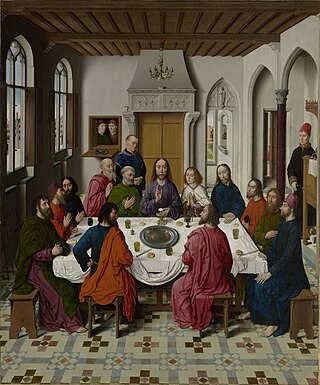
The Last Supper of Jesus and the Twelve Apostles has been a popular subject in Christian art, often as part of a cycle showing the Life of Christ. Depictions of the Last Supper in Christian art date back to early Christianity and can be seen in the Catacombs of Rome.

After Luther's objections to large public religious images had started to fade, Lucas Cranach the Elder, along with his son and workshop began to work on several altarpieces of the Last Supper, among other subjects.

Madonna with Child with Young John the Baptist is a painting by the German Renaissance painter Lucas Cranach the Elder, dating from 1514. It is housed in the Uffizi Gallery of Florence.
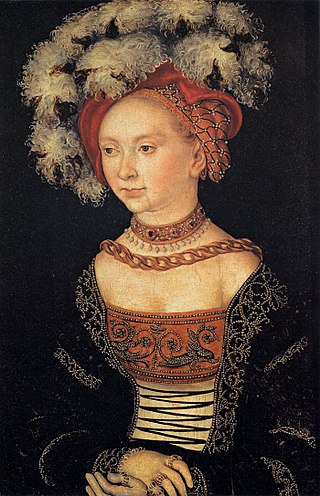
The Female Portrait is a painting by German Renaissance master Lucas Cranach the Elder, dating from around 1530, now housed in the Uffizi Gallery of Florence, Italy.
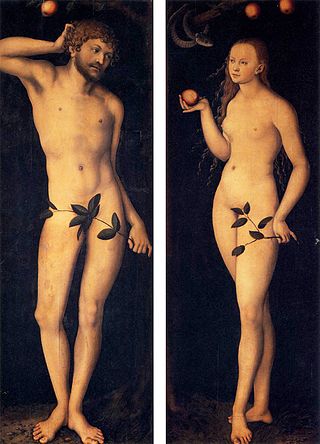
Adam and Eve is a pair of paintings by German Renaissance master Lucas Cranach the Elder, dating from 1528, housed in the Uffizi, Florence, Italy.

Crucifixion is an oil painting by German artist Lucas Cranach the Elder. One of many versions of the subject painted by Cranach, this one, created in 1532, is now in the Indianapolis Museum of Art.

The Fountain of Youth is an oil-on-panel painting executed in 1546 by the German artist Lucas Cranach the Elder.
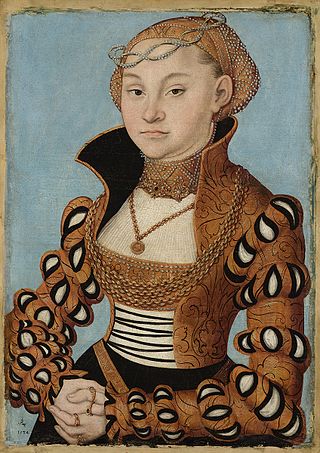
Portrait of a Saxon Noblewoman is an oil on canvas painting by Lucas Cranach the Elder. It has been in the Musée des Beaux-Arts de Lyon since 1892.

Portrait of a Knight of Malta is an oil on canvas painting by Titian, from c. 1515. It depicts a knight belonging to the Order of Malta. It is now in the Uffizi, in Florence.

Caritas is an oil on panel painting by German painter Lucas Cranach the Elder. The painting is kept in the Royal Museum of Fine Arts, Antwerp.

Adam and Eve is a c. 1538 oil on limewood painting by Lucas Cranach the Elder, acquired in 1949 from the Cistercian monastery in Osek near Duchcov, now in the National Gallery Prague.

Venus and Cupid with a Honeycomb is an oil painting by the German artist Lucas Cranach the Elder, one of the masters of the German Renaissance. It was probably executed in 1531 after Cranach met Georg Sabinus, a German poet, diplomat and academic at the University of Wittenberg. It is displayed in the Galleria Borghese, Rome. There are twenty-four paintings on this subject, replicated many times by the painter, including Venus and Cupid with a Honeycomb which belongs to the very first series that began in 1509. Another well known versions is Cupid Complaining to Venus, dated c. 1526–27 and preserved at the National Gallery in London.
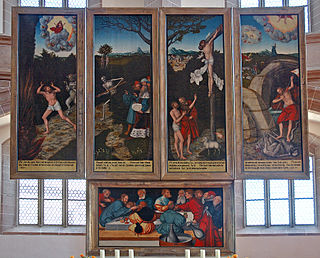
The Schneeberg Altarpiece is a Lutheran winged altarpiece created in 1539 by Lucas Cranach the Elder for the Church of St. Wolfgang in Schneeberg in Saxony, Germany. The altarpiece was commissioned in 1531–1532 by the Elector of Saxony John I of Saxony and installed in the church in 1539, making it the first Protestant altarpiece of Reformation which is considered a Saxon masterpiece of art.

Christ Blessing the Children is a religious oil painting created by the German Renaissance artist Lucas Cranach the Elder and his workshop in 1537.
Portrait of Martin Luther may refer to any oil painting from a series of portrayals of Martin Luther by Lucas Cranach the Elder. That artist and his studio produced countless painted and printed portraits of Luther and it is often difficult to determine to what extent the paintings are autograph works. They often formed a diptych with a portrait of Luther's wife Katharina von Bora or his close associate Philipp Melanchthon.

Paintings of Adam and Eve by Lucas Cranach the Elder include the following, depicted either together in a double portrait or separately in a pair of paintings:



















